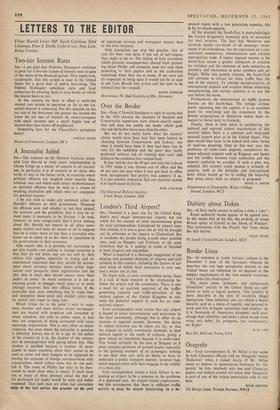London's Third Airport?
- Sta,--Stansted is a poor site for the United King- dom's next major international airport, but not solely for the reasons of rural inconvenience given by your correspondent. Considered by airport loca- tion criteria, it is also a poor site as will be brought out by witnesses at the inquiry at Chelmsford. But to condemn the people living around other possible sites, such as Sheppey and Foulness, to the same irritations that he is seeking to avoid at Stansted is both illogical and unjustified.
What is required is a thorough reappraisal of the existing and potential demands of airports and civil aviation in this country, including the factors of air- port siting of which rural annoyance is only one, and a minor one at that.
To begin with, as your correspondent states, there is a lack of basic research in the relationship be- tween the airport and the community. There is also a need for an accurate appraisal of the traffic- generating capacity and traffic-attraction of the various regions of the United Kingdom to esti- mate the potential support in each for an inter- national airport.
Your correspondent must realise that any airport is bound to cause inconvenience and annoyance to the local community, although this is offset by an increase in regional income. However, this desire to reduce irritation can be taken too far, so that the airport, to satisfy community demands, is sited without regard to the needs of aviation, giving a poor return on investment because it is under-used. This would certainly be the case at Sheppey as it poses complex problems of ground access, especially to the growing numbers of air passengers wishing to use their own cars with no desire to have to undertake a public transport journey, however fast, which deposits them with their baggage in the middle of a busy city.
Your correspondent makes a basic fallacy in ex- pecting an airport to 'be a panacea to the problems of a depressed area. An airport creates employment, but this presupposes that there is sufficient traffic activity to keep the airport functioning. In a de-
pressed region with a low generating capacity, this is by no means assured.
At the moment the South-East is overwhelmingly the United Kingdom's dominant pole of attraction for civil aviation. The fact that Heathrow and Gatwick handle two-thirds of all passenger move- ments is no coincidence, but the expression of a con- centrated commercial, administrative and cultural metropolitan node. A higher regional income in the South-East means a greater utilisation of aviation for holidays and the existence of such industries as jewellery and electronics in great numbers aids air freight. While this pattern remains, the South-East will continue to attract far more traffic than the rest of the country. To attempt decentralisation of international airports and aviation before dispersing manufacturing and service industry is to put the cart before the horse.
Furthermore, the international air traffic pattern focuses on the South-East. The foreign airlines prefer operating into the capital; it is an excellent point for interlining' and the investment by the British corporations at Heathrow makes them re- luctant to move, even to Gatwick.
Finally, there is little point in considering the national and regional airport requirements of this country unless there is a coherent and integrated national airport plan as in the United States. This plan would then have to be linked with other forms of land-use planning. Only in this way may the problems of under-used airports, competition be- tween adjacent airports such as Ringway and Speke and the conflict between local authorities and the airports authority be avoided. If such a plan was adopted, this country could possess a network of airports, both at the domestic and international level, which would go far to ending the bickering that arises every time an airport is proposed.
Department of Geography, King's College, Strand, London, WC2






























 Previous page
Previous page